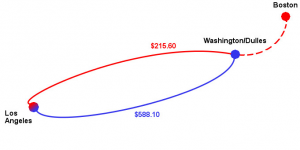The other day I called United Airlines to see if I could catch the second leg of my flight home from Scotland, at London Heathrow since I would already be there at the time of my departure. They responded with a, “yes, but this change will be a fee of $800”, to which I declined as it was more than half the ticket price. This got me thinking, why would an airline charge me so much to not board part of my flight, even if I paid for the entire ticket. The answer is hidden city ticketing.
Hidden city ticketing is technically a legal method that can be used to obtain cheaper airfare tickets by simply abandoning the second leg of the connecting flight, made popular by the website Skiplagged. Since flight fares are not dictated by the number of miles traveled, it is possible that a ticket exists that would take you through the airport of your desired destination to a random endpoint for a cheaper price than purchasing a direct ticket. There are some cons associated with this method, for example the inability to check any luggage since it would be sent to the random endpoint, rather than where you plan to get off. Another problem is that once the second leg of the flight isn’t boarded, the airline will cancel the rest of the flight even if it is a round trip ticket.
Although economically this premise may make no sense, when looking closer at airline pricing power and competition it is apparent that they are the two main drivers of this price difference. It can be assumed that almost every passenger prefers a direct flight to a flight with a connection. In many cases there is only one airline that offers a direct flight from point A to point B, which puts them in a slightly monopolistic position. There are other ways to get from point A to point B, but that may take twice as long, so the firm that offers a direct flight has the power to charge whatever they like since their product isn’t homogenous to the other indirect flights to that same destination.
But the airlines that exhibit cases of hidden city ticketing are ones that operate connecting flight routes that many other airlines offer, which are therefore more common and desired routes. Since there are more competitors for these routes there are often brutal price competitions, due to the high demand elasticity of airfare. After this price war it ends up costing less to travel further.
Another aspect to take into account is the hub itself, and why this system works. People want to get exactly where they want to be and get there with one plane. The only way to satisfy this demand was to create a hub in which airlines could supply frequent direct flights to its high paying customers, but also connect other people through those flights to fill the rest of the plane and justify its fixed operating cost.
The airlines that have direct flights that continue through hubs are harmed by the loss of revenue that technically should have gone to them if it were just supply and demand being observed. Since these airlines could have captured the demand for a direct flight from point A to B, but were beat in price by the same plane ticket that flies through this hub, the customers that switch over to hidden city tickets are the lost revenue. It is because they switch over from being high paying customers to being low paying customers. This airline booking ploy is just another reason that airlines have to be so cautious, and end up implementing large ticket alternation fees.


If there were I like button, I’d click it. Very interesting.